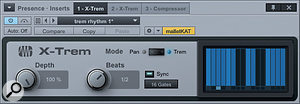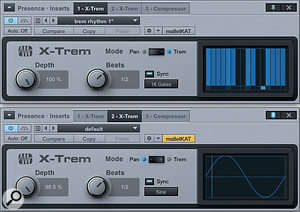Get the rhythm with Studio One's X-Trem and pattern sequencers.
 1: X-Trem has simple controls but can produce surprisingly complex rhythmic effects.
1: X-Trem has simple controls but can produce surprisingly complex rhythmic effects.
Most electronic music today focuses on the beat. Since dance music typically has little dynamic range, rhythmic panning and level variation are tricks often used to add interest to the musical texture.
Many on the Studio One development team are electronic musicians, so the program contains features that impose rhythmic level variations onto tracks. Rather than explain them, I'm going to demonstrate, with the techniques laid out in this column. I've provided audio examples, which I'll refer you to throughout. You can find them at /sos/jun13/articles/studio_one_media.htm.
Steps To Success
The LFO (Low Frequency Oscillator) is one of the most common tools for adding rhythm and movement to a track. I like LFOs quite a bit, but I find the 16-step pattern sequencers that Studio One tucks into a few key locations endlessly rewarding. Creating a simple repeating pattern takes virtually no effort, but the real fun comes when you start increasing the complexity by combining methods or using multiple processors.
This column has previously mentioned the X-Trem plug-in because it is so useful in this area. X-Trem comes bundled with Studio One, and the simplicity of its user interface belies the potential of its capabilities. As you can see in picture 1, X-Trem has few controls, and their functions are fairly self-evident: 'Depth' controls how intensely the effect is projected onto the signal, 'Beats' gives the note value for a complete cycle of whatever LFO option is chosen, and 'Sync', of course, locks the LFO to the Song tempo.
X-Trem's real power comes largely from two features. First, its Mode switch, which toggles it between tremolo effects (overall level variation) and panning effects (channel-to-channel level variation). Second, you will see in the LFO Type drop-down menu to the right of the Beats knob (shown in picture 1) that, in addition to offering the four standard synthesizer waveforms for the LFO, X-Trem also includes two more interesting options: 16-gate and 16-step sequencers. The difference between these two choices is that the gate sequencer offers only 'on' or 'off' values, while the step sequencer allows in-between values, too.
 2: Here the X-Trem has a Beats value of 1/2, which is half a bar, or a two-beat cycle.The gate sequencer, when used in tremolo mode, imprints a rhythm on the signal by switching it off and on according to the pattern in X-Trem's grid. The rhythm is created by those steps where gates are switched off. This is how a sustained pad is turned into a surging groove. In picture 2, X-Trem has a Beats value of 1/2, meaning half a bar, or a two-beat cycle. With 16 steps in total, each step represents a 32nd-note, so the rhythm shown was formed by removing the fourth 16th-note of beat one and the second 16th-note of beat two. (Listen to X-Trem_tremolo_only.wav to hear this.)
2: Here the X-Trem has a Beats value of 1/2, which is half a bar, or a two-beat cycle.The gate sequencer, when used in tremolo mode, imprints a rhythm on the signal by switching it off and on according to the pattern in X-Trem's grid. The rhythm is created by those steps where gates are switched off. This is how a sustained pad is turned into a surging groove. In picture 2, X-Trem has a Beats value of 1/2, meaning half a bar, or a two-beat cycle. With 16 steps in total, each step represents a 32nd-note, so the rhythm shown was formed by removing the fourth 16th-note of beat one and the second 16th-note of beat two. (Listen to X-Trem_tremolo_only.wav to hear this.)
Backing off on the Depth control changes the character of the effect so that it adds accents to the signal more than it imprints the rhythm. (Listen to X-Trem_tremolo_only_depth75.wav to hear the same thing as in the first example, but with Depth set to 75 percent instead of 100 percent.)
Choosing a different length for the cycle entirely alters the feel that can be produced. For example, setting Beats to 1/4 instead of 1/2 lets you produce a flutter effect by alternating on and off gates (which, at that Beats setting, represent 64th-notes).
Rhythmic tremolo can be enhanced even further by layering rhythmic panning on top of it. We can do that with a second instance of X-Trem inserted below the first. In picture 3 (and also in the audio example X-Trem_2x_tremolo_and_pan.wav), a second instance of X-Trem is set to produce simple sine LFO panning, sync'ed to the tempo, of course.
If the Beats setting for the tremolo is 1/2, a Beats setting of 1/2T (triplets) for the panning lets you create three-against-two polyrhythms (see X-Trem_2x_different_cycle_lengths.wav). The Beats control ranges from 1/64T up to four bars, presenting a very wide range of possibilities.
Smooth Operation
 3: A second instance of X-Trem has been set to produce sine LFO panning.
3: A second instance of X-Trem has been set to produce sine LFO panning.
A given rhythm won't necessarily work equally well for tremolo and panning. Syncopated rhythms that sound awesome as tremolo sometimes feel jumpy when used for panning. One solution is to use less complex rhythms, but backing off Depth can bring more smoothness and a better feel to panning with syncopation. It's all about the interaction between the rhythm, the signal being processed, and the musical context; sometimes panning sounds good with a rhythm just as complex as one used for tremolo, but that emphasises different beats.
X-Trem's step sequencer provides more subtlety and sophistication than the gate sequencer. I find that the step sequencer is more often useful for panning than tremolo, but it certainly can produce cool tremolo effects, too. The audio file X-Trem_stepseq_pan_depth50.wav displays X-Trem settings for a step sequence autopan with Depth set to 50 percent, which, while noticeable, is not as 'jumpy' as when Depth is set much higher.
Automation
For really intense effects, you can automate X-Trem. Automating the Depth control lets you fade in a tremolo or panning effect similarly to the way in which vibrato is often faded in. Automating Beats can give some pretty flippy jumps in rhythm, all of which stay in sync as long as the Sync button is engaged. You can also map one or more parameters to a control surface and vary them in real time.
Automation for X-Trem is not limited to Depth and Beats; each individual gate can be automated as well. X-Trem does not allow saving and recalling of gate or step patterns (more's the pity). Automating gates is a functional, if inefficient, workaround for this. The possibilities here can quickly get quite trippy.
In the examples described here, X-Trem is inserted on the mixer channel for the Presence instrument. Parameters for Instrument channel inserts are not automatable on Instrument tracks, so to automate X-Trem when it is inserted on an Instrument channel, you'll need to add an automation track. If X-Trem is inserted on an Audio track, its parameters will be available for automation on the Audio track itself.
The Presence Of Gateness
 4: The other place to find a pattern sequencer in Studio One is on the bundled Presence instrument.
4: The other place to find a pattern sequencer in Studio One is on the bundled Presence instrument.
X-Trem is not the only place where you can find a pattern sequencer in Studio One: the Presence sample-player instrument that's bundled with the program has an effects section containing a 16-step pattern gate for tremolo. It's useful to bear in mind that a filled step in X-Trem means that the gate is on, while in Presence the unfilled step is a gate on.
Open Presence in an editor window and click the Edit FX button; the gate sequencer will be front and centre. It is enabled by ticking the box in its upper-left corner. Like X-Trem, this sequencer has a grid and Beats and Depth controls — but Presence also has a few extra tricks up its sleeve.
To the right of the grid, you'll find two buttons: Pattern and Stereo. The Pattern button drops down a menu offering nine preset patterns and a 'Clear' selection. That's handy, but what we are really interested in is the Stereo button.
Click the Stereo button and you'll see the grid divide into upper and lower halves. The upper half is the pattern that will be played on the left channel, while the lower half represents the right channel. You've just doubled your possibilities; now any given sequence step can sound on the left channel, right channel, both channels, or not at all, essentially combining tremolo and autopanning.
Presence's Gate section can thus produce effects similar to those I explained above with two instances of X-Trem, where a panning rhythm layers on top of a gate rhythm. Or you could have signals in both channels only directly on beats, and in one channel or the other (or removed altogether) in between. Perhaps the channel could switch only on eighth notes, but the gates occur on 16ths, as another possibility. Rhythms can be combined through gating and panning relationships between the two channels to produce very sophisticated textures, especially with other instruments in the mix playing interrelated rhythms.
Presence still has one more trick to offer: the Pan section. This autopanner is much simpler than X-Trem's; it simply moves between channels at the rate set by the Beats control. The interaction of panning by the Gate section with panning by the Pan section can get very interesting when their Beats settings are different. For example, set Beats on the Gate section to 1/2 and then set Beats in the Pan section to 1/2D (dotted half-note, or three beats). If the musical passage is rhythmic and motivic (that is, repeating with variations), the results can have lots of motion. (See audio example Presence_gate_and_pan.wav.)
Layers Of Complexity
The more layers you pile on, the more complexity you generate. Presence has tempo-sync'able delay that can be added, and you can throw in an instance or two of X-Trem on the Presence channel, too, if you like. For that matter, the bundled Autofilter plug-in also contains a pattern sequencer.
Still not crazy enough? Try turning Sync off in one or more places (depending on how many rhythmic panners you've got going). The more variables and panners/tremolos you introduce, the simpler you will want to make each individual element. Under those circumstances, you may want to avoid short Beats settings, and back off Depth settings in some places.
When you're looking to create a churning, rhythmic texture, Studio One's pattern sequencer features can be a fertile source of ideas and motion and, as you can see, they really lend themselves to experimentation.
